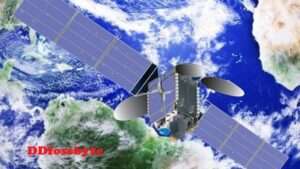NASA’s latest satellite, TEMPO (Tropospheric Emissions: Monitoring of Pollution), is revolutionizing our ability to monitor and assess air quality on a global scale. With increasing concerns about air pollution and its impact on health and the environment, this cutting-edge technology is poised to make a significant difference in our understanding of atmospheric conditions.

NASA’s Tropospheric Emissions: Monitoring of Pollution (TEMPO) satellite has released its first images of air pollution in North America. The images, which show concentrations of nitrogen dioxide gas, reveal how pollution levels vary across the continent from hour to hour.
A Clear Vision from Above
TEMPO, perched aboard the International Space Station, is equipped with state-of-the-art sensors that can measure a wide range of pollutants and gases present in Earth’s lower atmosphere, also known as the troposphere. This advanced satellite technology provides an unprecedented view of the distribution and movement of pollutants, allowing scientists to gain insights into the sources and patterns of air pollution.
Mapping Pollutants in Real-Time
One of TEMPO’s remarkable features is its ability to provide real-time data and high-resolution maps of pollutants. This data-rich information is invaluable for policymakers, researchers, and environmental agencies striving to address the challenges of air quality management. By identifying pollution hotspots and understanding the dynamics of pollutants, governments and organizations can make informed decisions to mitigate their adverse effects.

Unveiling the Impact of Human Activities
TEMPO’s data collection capabilities extend beyond just identifying pollutants. The satellite’s observations shed light on the link between human activities, emissions, and air quality. This knowledge is instrumental in devising strategies to reduce emissions, enhance air quality, and promote sustainable development.
Health and Environmental Implications
The insights gathered from TEMPO’s observations have far-reaching implications for public health and the environment. Air pollution is associated with a range of health issues, including respiratory diseases and cardiovascular problems. By accurately tracking pollutants and their movement, scientists can assess the risks posed to communities and ecosystems, aiding in the development of targeted interventions.
Collaborative Efforts
NASA’s TEMPO satellite is a product of collaborative efforts involving various international partners and organizations. The global nature of air pollution demands a collective approach, and TEMPO’s data-sharing initiatives contribute to a broader understanding of air quality challenges worldwide.

A Beacon of Hope
As concerns about climate change and environmental degradation mount, TEMPO emerges as a beacon of hope. Its cutting-edge technology not only advances scientific knowledge but also empowers societies to take proactive measures to safeguard air quality and the planet.
Looking Ahead
The launch and deployment of TEMPO mark a significant step forward in harnessing space technology for the betterment of humanity. The satellite’s ability to provide real-time, accurate, and comprehensive data on air quality is a testament to the remarkable progress made in space science and its applications for addressing global challenges.

TEMPO is the first satellite to provide real-time measurements of air pollution over North America. The satellite’s high-resolution images can detect pollution levels down to four square miles. This will allow scientists to track the movement of pollution and identify sources of emissions.
The data from TEMPO will be used by scientists, policymakers, and public health officials to improve air quality in North America. The data could also be used to develop new strategies for reducing emissions and mitigating the effects of climate change.

Here are some of the key benefits of TEMPO:
- Provides real-time measurements of air pollution
- Can detect pollution levels down to four square miles
- Helps to track the movement of pollution and identify sources of emissions
- Can be used to improve air quality and mitigate the effects of climate change
Here are some of the challenges that TEMPO faces:
- Can be affected by cloud cover
- May not be able to detect all types of air pollutants
- Data may not be available in real time for all areas

NASA’s TEMPO satellite represents a pivotal advancement in our ability to monitor air quality and understand the intricacies of atmospheric pollutants. As it continues to collect data and contribute to our knowledge of air pollution, TEMPO becomes a vital tool in the fight against environmental degradation and a source of inspiration for fostering a cleaner and healthier planet for future generations.
